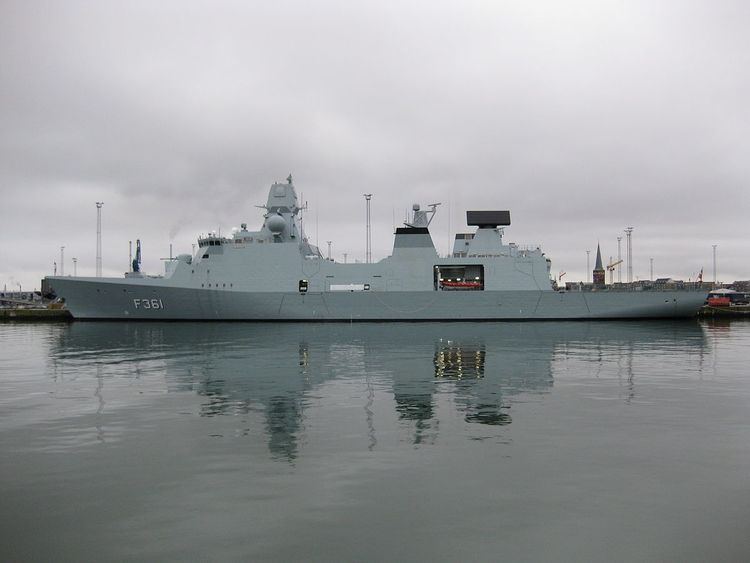Built 2008–2011 | Cost US$325M/ship In commission 2012 onwards | |
 | ||
Builders Odense StaalskibsværftBaltija Shipbuilding YardLoksa Shipyard Preceded by Niels Juel-class corvette | ||
The Iver Huitfeldt class is a three-ship class of frigates that entered service with the Royal Danish Navy in 2012 and 2013.
Contents
Description
The class is built on the experience gained from the Absalon-class support ships, and by reusing the basic hull design of the Absalon class the Royal Danish Navy have been able to construct the Iver Huitfeldt class considerably cheaper than comparable ships. The frigates are compatible with the Danish Navy's StanFlex modular mission payload system used in the Absalons, and are designed with slots for six modules. Each of the four stanflex positions on the missile deck is able to accommodate either the Mark 141 8-cell Harpoon launcher module, or the 12-cell Mark 56 ESSM VLS. The Peter Willemoes passed the British Flag Officer Sea Training test in 2015.
While the Absalon-class ships are primarily designed for command and support roles, with a large ro-ro deck, the three new Iver Huitfeldt-class frigates will be equipped for an air defence role with Standard Missiles, and the potential to use Tomahawk cruise missiles, a first for the Danish Navy.
The ships were constructed in blocks in Estonia and Lithuania. These blocks were then towed to Odense where they were assembled. Compared to the similar De Zeven Provinciën and Sachsen class frigates, the ships of the Iver Huitfeldt-class is lacking a gas-driven propulsion.
The builder's successor, OMT, suggests the type for the Procurement programme of the Royal Australian Navy's frigates, but built in Australia and modified for anti-submarine warfare. The type is also suggested for Canada's Single Class Surface Combatant Project.
Anti-air warfare
The weapons for the three ships were reused from the previous Niels Juel-class corvette and the Flyvefisken-class patrol vessel. Other components were reused as well to keep the cost at a minimum.
These ships share their Anti-Air Warfare suite with the Royal Netherlands Navy's De Zeven Provinciën-class frigates and the German Navy's Sachsen-class frigates. The sensors of this suite include the long range surveillance radar SMART-L (passive electronically scanned array) and the multi-function radar APAR active electronically scanned array. The SMART-L and APAR are highly complementary, in the sense that SMART-L is a L band radar providing very long range surveillance while APAR is an I band radar providing precise target tracking, a highly capable horizon search capability, and missile guidance using the Interrupted Continuous Wave Illumination (ICWI) technique, thus allowing guidance of 32 semi-active radar homing missiles in flight simultaneously, including 16 in the terminal guidance phase. The primary anti-air weapons are the point defence Evolved Sea Sparrow Missile and the area defence SM-2 IIIA. The Mk 41 Vertical Launch System is used to house and launch these missiles. Depending on the number of Harpoon launchers installed, up to 48 Evolved Sea Sparrow Missile and 32 SM-2 IIIA may be carried.
There are no SM-2 missiles purchased as of today and no money is available for the navy to do so under the current budget period. Plans to include the ships in the future missile shield is only as a sensor and as of today only one unit.
